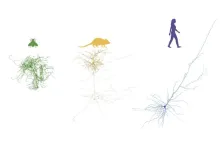(Press-News.org) It may seem like the Sun is stationary while the planets in its orbit are moving, but the Sun is actually orbiting around the Milky Way galaxy at an impressive rate of about 220 kilometers per second — almost half a million miles per hour. As fast as that may seem, when a faint red star was discovered crossing the sky at a noticeably quick pace, scientists took notice.
Thanks to the efforts of a citizen science project called Backyard Worlds: Planet 9 and a team of astronomers from around the country, a rare hypervelocity L subdwarf star has been found racing through the Milky Way. More remarkably, this star may be on a trajectory that causes it to leave the Milky Way altogether. The research, led by University of California San Diego Professor of Astronomy and Astrophysics Adam Burgasser, was presented today at a press conference during the 244th national meeting of the American Astronomical Society (AAS) in Madison, Wisconsin.
The star, charmingly named CWISE J124909+362116.0 (“J1249+36”), was first noticed by some of the over 80,000 citizen science volunteers participating in the Backyard Worlds: Planet 9 project, who comb through enormous reams of data collected over the past 14 years by NASA's Wide-field Infrared Survey Explorer (WISE) mission. This project capitalizes on the keen ability of humans, who are evolutionarily programmed to look for patterns and spot anomalies in a way that is unmatched by computer technology. Volunteers tag moving objects in data files and when enough volunteers tag the same object, astronomers investigate.
J1249+36 immediately stood out because of the speed at which it is moving across the sky, initially estimated at about 600 kilometers per second (1.3 million miles per hour). At this speed, the star is fast enough to escape the gravity of the Milky Way, making it a potential “hypervelocity” star.
To better understand the nature of this object, Burgasser turned to the W.M. Keck Observatory in Maunakea, Hawaii to measure its infrared spectrum. These data revealed that the object was a rare L subdwarf — a class of stars with very low mass and temperature. Subdwarfs represent the oldest stars in the Milky Way.
The insight into J1249+36’s composition was made possible by a new set of atmosphere models created by UC San Diego alumnus Roman Gerasimov, who worked with UC LEADS scholar Efrain Alvarado III to generate models specifically tuned to study L subdwarfs. “It was exciting to see that our models were able to accurately match the observed spectrum,” said Alvarado, who is presenting his modeling work at the AAS meeting.
The spectral data, along with imaging data from several ground-based telescopes, allowed the team to accurately measure J1249+36’s position and velocity in space, and thereby predict its orbit through the Milky Way. “This is where the source became very interesting, as its speed and trajectory showed that it was moving fast enough to potentially escape the Milky Way,” stated Burgasser.
What gave this star a kick?
Researchers focused on two possible scenarios to explain J1249+36’s unusual trajectory. In the first scenario, J1249+36 was originally the low-mass companion of a white dwarf. White dwarfs are the remnant cores of stars that have depleted their nuclear fuel and died out. When a stellar companion is in a very close orbit with a white dwarf, it can transfer mass, resulting in periodic outbursts called novae. If the white dwarf collects too much mass, it can collapse and explode as a supernova.
“In this kind of supernova, the white dwarf is completely destroyed, so its companion is released and flies off at whatever orbital speed it was originally moving, plus a little bit of a kick from the supernova explosion as well,” said Burgasser. “Our calculations show this scenario works. However, the white dwarf isn’t there anymore and the remnants of the explosion, which likely happened several million years ago, have already dissipated, so we don’t have definitive proof that this is its origin.”
In the second scenario, J1249+36 was originally a member of a globular cluster, a tightly bound cluster of stars, immediately recognizable by its distinct spherical shape. The centers of these clusters are predicted to contain black holes of a wide range of masses. These black holes can also form binaries, and such systems turn out to be great catapults for any stars that happen to wander too close to them.
“When a star encounters a black hole binary, the complex dynamics of this three-body interaction can toss that star right out of the globular cluster,” explained Kyle Kremer, an incoming Assistant Professor in UC San Diego’s Department of Astronomy and Astrophysics. Kremer ran a series of simulations and found that on rare occasions these kinds of interactions can kick a low-mass subdwarf out of a globular cluster and on a trajectory similar to that observed for J1249+36.
“It demonstrates a proof of concept,” said Kremer, “but we don’t actually know what globular cluster this star is from.” Tracing J1249+36 back in time puts it in a very crowded part of the sky that may hide undiscovered clusters.
To determine whether either of these scenarios, or some other mechanism, can explain J1249+36’s trajectory, Burgasser said the team hopes to look more closely at its elemental composition. For example, when a white dwarf explodes, it creates heavy elements that could have “polluted” the atmosphere of J1249+36 as it was escaping. The stars in globular clusters and satellite galaxies of the Milky Way also have distinct abundance patterns that may reveal the origin of J1249+36.
“We’re essentially looking for a chemical fingerprint that would pinpoint what system this star is from,” said Gerasimov, whose modeling work has enabled him to measure the element abundances of cool stars in several globular clusters, work he is also presenting at the AAS meeting.
Whether J1249+36’s speedy journey was because of a supernova, a chance encounter with a black hole binary, or some other scenario, its discovery provides a new opportunity for astronomers to learn more about the history and dynamics of the Milky Way.
END
Lone Star State: Tracking a low-mass star as it speeds across the Milky Way
A newly discovered L subdwarf is on an unusual journey through our galaxy
2024-06-10
ELSE PRESS RELEASES FROM THIS DATE:
Researchers demonstrate the first chip-based 3D printer
2024-06-10
CAMBRIDGE, MA – Imagine a portable 3D printer you could hold in the palm of your hand. The tiny device could enable a user to rapidly create customized, low-cost objects on the go, like a fastener to repair a wobbly bicycle wheel or a component for a critical medical operation.
Researchers from MIT and the University of Texas at Austin took a major step toward making this idea a reality by demonstrating the first chip-based 3D printer. Their proof-of-concept device consists of a single, millimeter-scale photonic ...
Making remanufacturing profitable
2024-06-10
Returning end-of-life products to as-new condition is called remanufacturing and can be an essential element in a circular economy. But for more industrial companies to take an interest in it, remanufacturing needs to be economically viable. In a doctoral thesis from Linköping University, Johan Vogt Duberg has investigated how this can be accomplished.
“It’s possible to take advantage of increased environmental awareness to gain economic benefits. With remanufacturing, the costs of raw materials can be reduced, new customer groups found and ...
NSF awards additional $9.8 Million for Delta, DeltaAI
2024-06-10
The National Center for Supercomputing Applications was recently awarded $4.9 million of supplemental funding from the U.S. National Science Foundation (NSF) for Delta and an additional $4.9 million for DeltaAI to expand the potential capabilities of the soon-to-launch system by nearly 50 percent.
NCSA originally received nearly $25 million from NSF in 2023 to deploy and operate DeltaAI, an advanced computing and data resource that will be a companion system to Delta. DeltaAI will triple NCSA’s AI-focused computing capacity and ...
Breakthrough in creating cyclic peptide opens the way for new antibiotics
2024-06-10
A discovery made by scientists at King’s College London could speed up efforts to produce new antibiotics in the fight against antimicrobial resistance.
In a paper published in the Journal of the American Chemical Society, scientists from the Department of Chemistry share a new, rapid method for making cyclic peptides – an important class of antibiotic molecules. The approach takes minutes rather than the hours or days it normally takes, helping overcome a major challenge in antibiotic development.
Lead author Dr Sarah Barry, from the Department of Chemistry at King’s College London, ...
Unregulated sales of a toxic and hallucinogenic mushroom endanger public health
2024-06-10
Americans’ interest in a potentially harmful “magic mushroom” is soaring, with Google searches skyrocketing 114 percent from 2022 to 2023, according to a new study by researchers at the University of California San Diego Herbert Wertheim School of Public Health and Human Longevity Science. In a paper published in the American Journal of Preventive Medicine, the scientists suggest that the growing market for Amanita muscaria may be sparked in part by emerging clinical research supporting the safety and efficacy of psilocybin as a treatment ...
Alarming trends call for action to define the future role of food in nation’s health
2024-06-10
CHICAGO, June 10, 2024 — The cost of nutritious food and the lack of access to it are of significant concern to U.S. consumers. That’s according to a new national poll of public attitudes on food and nutrition conducted by Zogby Analytics on behalf of Research!America and the American Heart Association. Nearly 7 in 10 (68%) respondents recognize healthy eating habits as an important factor in improving a person’s chance for a long and healthy life. Yet more than half (53%) say the United ...
Case studies show how quasi-governmental organizations could strengthen climate adaptation governance
2024-06-10
The politicization of climate issues and the unsynchronized efforts of stakeholders are hindering the effectiveness of climate adaptation governance in the U.S. According to a new study(Link is external) published by Princeton researchers, the design characteristics of quasi-governmental organizations (QGOs) could provide insights on how to depoliticize climate information sources and foster multi-level stakeholder coordination.
Quasi-governmental organizations are entities that have a combination of public and private characteristics, utilizing both for-profit and not-for-profit ...
Brain’s structure hangs in ‘a delicate balance’
2024-06-10
When a magnet is heated up, it reaches a critical point where it loses magnetization. Called “criticality,” this point of high complexity is reached when a physical object is transitioning smoothly from one phase into the next.
Now, a new Northwestern University study has discovered that the brain’s structural features reside in the vicinity of a similar critical point — either at or close to a structural phase transition. Surprisingly, these results are consistent across brains from humans, mice and fruit flies, which suggests the finding might be universal.
Although the researchers don’t ...
Protein study could help researchers develop new antibiotics
2024-06-10
A bacterial enzyme called histidine kinase is a promising target for new classes of antibiotics. However, it has been difficult to develop drugs that target this enzyme, because it is a “hydrophobic” protein that loses its structure once removed from its normal location in the cell membrane.
Now, an MIT-led team has found a way to make the enzyme water-soluble, which could make it possible to rapidly screen potential drugs that might interfere with its functions.
The researchers created their new version ...
Two can play that game: juvenile dolphins who play together are more successful as adults
2024-06-10
Juvenile social play predicts adult reproductive success in male bottlenose dolphins, a new study has found.
Fresh findings published today in Proceedings of the National Academy of Sciences led by researchers from the University of Bristol and University of Western Australia, show that juvenile male dolphins with strong social bonds practice adult-like reproductive behaviours when playing together, and those juvenile males who spend more time practicing will father more offspring as adults. The study provides rare evidence for a link between juvenile social play and reproductive success in a wild animal.
In collaboration with international colleagues, the ...
LAST 30 PRESS RELEASES:
Tracing the quick synthesis of an industrially important catalyst
New software sheds light on cancer’s hidden genetic networks
UT Health San Antonio awarded $3 million in CPRIT grants to bolster cancer research and prevention efforts in South Texas
Third symposium spotlights global challenge of new contaminants in China’s fight against pollution
From straw to soil harmony: International team reveals how biochar supercharges carbon-smart farming
Myeloma: How AI is redrawing the map of cancer care
Manhattan E. Charurat, Ph.D., MHS invested as the Homer and Martha Gudelsky Distinguished Professor in Medicine at the University of Maryland School of Medicine
Insilico Medicine’s Pharma.AI Q4 Winter Launch Recap: Revolutionizing drug discovery with cutting-edge AI innovations, accelerating the path to pharmaceutical superintelligence
Nanoplastics have diet-dependent impacts on digestive system health
Brain neuron death occurs throughout life and increases with age, a natural human protein drug may halt neuron death in Alzheimer’s disease
SPIE and CLP announce the recipients of the 2025 Advanced Photonics Young Innovator Award
Lessons from the Caldor Fire’s Christmas Valley ‘Miracle’
Ant societies rose by trading individual protection for collective power
Research reveals how ancient viral DNA shapes early embryonic development
A molecular gatekeeper that controls protein synthesis
New ‘cloaking device’ concept to shield sensitive tech from magnetic fields
Researchers show impact of mountain building and climate change on alpine biodiversity
Study models the transition from Neanderthals to modern humans in Europe
University of Phoenix College of Doctoral Studies releases white paper on AI-driven skilling to reduce burnout and restore worker autonomy
AIs fail at the game of visual “telephone”
The levers for a sustainable food system
Potential changes in US homelessness by ending federal support for housing first programs
Vulnerability of large language models to prompt injection when providing medical advice
Researchers develop new system for high-energy-density, long-life, multi-electron transfer bromine-based flow batteries
Ending federal support for housing first programs could increase U.S. homelessness by 5% in one year, new JAMA study finds
New research uncovers molecular ‘safety switch’ shielding cancers from immune attack
Bacteria resisting viral infection can still sink carbon to ocean floor
Younger biological age may increase depression risk in older women during COVID-19
Bharat Innovates 2026 National Basecamp Showcases India’s Most Promising Deep-Tech Ventures
Here’s what determines whether your income level rises or falls
[Press-News.org] Lone Star State: Tracking a low-mass star as it speeds across the Milky WayA newly discovered L subdwarf is on an unusual journey through our galaxy


